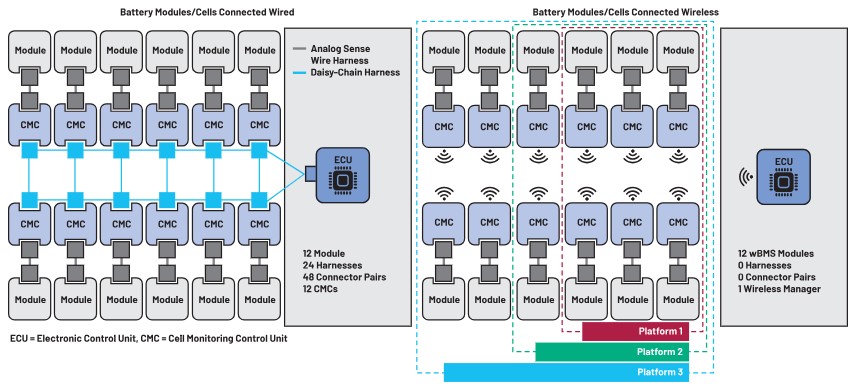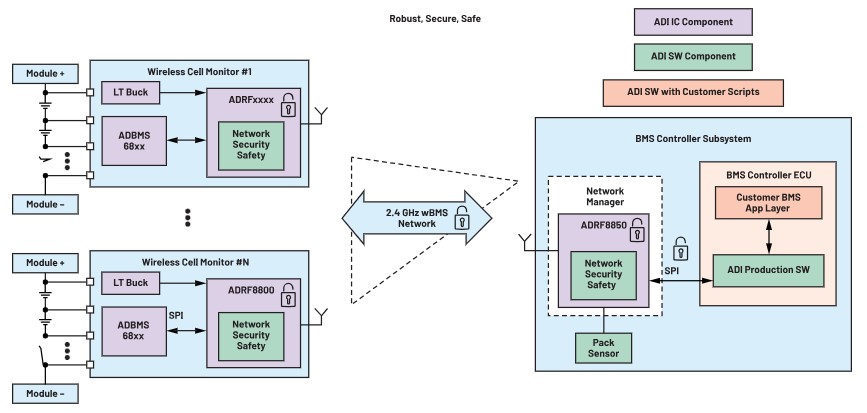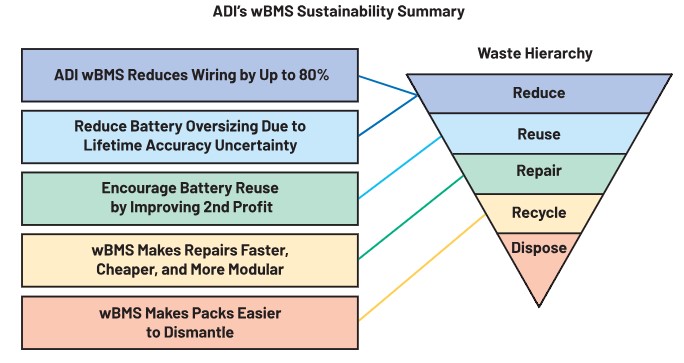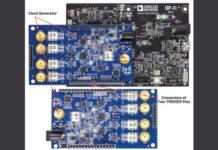Introduction
Analog Devices (ADI) electrification solutions portfolio, ADI Recharge, is redefining how the electric mobility and sustainable energy ecosystem can create and deliver greater value to the electric vehicle (EV) owner. ADI Recharge enables better EV operations and lifetime value of the battery, ultimately helping to improve the total cost of EV ownership. ADI is working with OEMs, Tier 1s, battery manufacturers, energy utility companies, and other stakeholders to build an information ecosystem from EV battery data that has never before been possible.
Electric Vehicles on the Rise
The combination of forward-looking government policies, technological advances, and the automotive industry’s commitment to sustainability are powerful forces to accelerate mass market EV adoption. Yet EVs are still not affordable for many, while for others their perceived value is still unclear. Government economic policies can support the EV agenda to a point, but disruptive innovation in electrification technology across transportation and the energy grid, business services must lead the way in breaking down the remaining barriers to EV adoption.
Technology companies have an important role to play. A significant factor to improve affordability is to use smarter, more efficient battery packs and powertrains. These systems must be safe, secure, and robust to deliver high performance for the user guaranteed across the vehicle’s lifetime. Advanced technology is required to grow the best battery cells, enable battery packs for robotic assembly, support zero cobalt chemistries such as LFP, and enable a circular battery lifecycle for recycling or reuse into energy storage systems.
Semiconductors and Software Leading the Path to Sustainable Transportation
ADI’s leading portfolio of electrification solutions, ADI Recharge, is empowering the automotive value chain, including car/fleet owners, OEMs, and Tier 1s, with disruptive capabilities. ADI Recharge includes leading solutions for battery technology, on-board chargers, power management, isolation technology. Together, these are transforming the EV battery and powertrain into a technologically advanced part of a vehicle’s overall capability. Central to this is ADI’s battery management system (BMS)—a complete system-level solution, including not only hardware but also software drivers and tools, that supports over-the-air software updates and achieves the highest automotive cybersecurity qualification (ISO 21434 CAL-4). Both wired and wireless operations are fully supported with ADI networking protocol. This solution not only enables OEMs to scale EV designs to their fleets, but it also brings secure intelligence at the edge to the battery cells. It transforms the battery pack into a software-defined platform, and the vehicle into a secure, connected, edge node.

A Robust Battery Insights Platform
ADI is helping to forge a new ecosystem where the value chain can leverage real-time battery data insights and deploy innovative solutions, which will drive better outcomes for EV vehicle/fleet owners by improving the lifetime value of the battery, and the EV’s operational performance. Building on our proven, industry-leading, high accuracy cell monitoring sensing capabilities, ADI’s solution delivers real-time battery data insights, utilizing secure intelligence at the edge, embedded software, and wireless communication links, which are critical to the development of new systems and services for the entire battery life cycle. The capabilities present opportunities for the vehicle/fleet owners to be benefitted by a value-based pricing structure, and for the manufacturers and suppliers to secure better variable costs with reduced overheads, while achieving faster time-to-market and production line efficiencies. These innovations are also helping create opportunities for a more reliable convergence of electric mobility with the clean energy grid.
So, what does the ADI battery insight platform look like end to end?
- Starting at the source of data—Intelligent sensors right at the battery cells gather data wirelessly into a central management platform, which presents the processed insights to the BMS engine control unit (ECU). ADI provides a production-grade software block from where the insights can be accessed, and the platform can be reconfigured via simple APIs.
- A closer look at the edge of the insights platform—The first and most critical integrated circuit (IC) connected to the cells is ADI’s seventh-generation cell monitoring sensor. Building on ADI’s leading measurement capability, this sensor adds new features that enable ground-breaking data insights. It can accurately analyze the battery charging state and health using the best accuracy in the industry guaranteed over lifetime. This sensor consumes ×20 less power than its predecessor, and some of that saved energy can be used to process valuable insights at the edge. Finally, just one IC can sense up to 100 V stack or 24 series cells making it a highly integrated and power-efficient battery sensor.
- Secure radio frequency microcontroller unit (RF MCU)—The IC’s embedded software controls the sensor operation and processes the data to feed ADI’s insights algorithms. These algorithms generate insights that can be used for applications such as fast charging and increased range, by estimating the state of charge (SoC) more accurately. The RF MCU’s ultrarobust radio and embedded network software transfer the insights to the BMS ECU. Each RF MCU includes a comprehensive security subsystem compliant with ISO 21434 CAL-4. A key feature is the unique secure identity of each IC, which can be leveraged to build an insights history for each battery.
- Central processing (BMS ECU)—ADI algorithms fuse the processed data from multiple edge nodes to create battery pack and vehicle-level insights.

System Value Across the Entire Battery Life Cycle
OEMs are moving quickly to electrify their vehicle fleets. Let’s explore a few important opportunities to empower sustained value delivery.
Automated EV Manufacturing
ADI Recharge eliminates the need for wiring harnesses. This enhances OEM’s robotic manufacturing capabilities so they are able to improve production line efficiency, reliability, battery pack assembly, and manufacturing costs. The system is supportive of all known battery chemistries, including low cost chemistries, and the increased modularity it provides to battery packs enables flexibility to scale EV production—from entry level to premium. As the wireless architecture is so robust, the software and network upgrades enable a reduction in battery material requirements. Compared to a wired network, the wireless network can be implemented quickly and easily and this greatly decreases development cycle time. There are also architectural-level savings enabled by ADI’s seventh-generation cell monitoring sensor—the ability to sense up to 24 channels using a single IC reduces coupling requirements, and the superior EMC performance eliminates the need for external components such as capacitors.
Digital Twins for Battery Packs
The age of the software vehicle is here. ADI’s system enables highly accurate digital twin services for battery packs. This targets first time right design by demonstrating ultrarobust RF performance, long before prototypes are available. This aids with improved battery pack design and planning, allowing for a much higher return on investment when in the development stages.
Improved Vehicle Reliability
Going wireless enables removing the wire harness, which not only saves cost but also removes potential sources of failure in the vehicle. Wires and connectors can weaken or fail over time. Furthermore, the platform can autonomously run deep battery tests during manufacturing and vehicle operations to detect the early signs of defects/failures, which could lead to severe safety issues for end customers.
Top Cybersecurity Qualification and the Battery Passport
For the ecosystem to build new systems and value-added services around the battery data, transparency, security, and ease of deployment are critical. ADI brought this technology to mass production as a turnkey solution with security designed in at every level. ADI’s wBMS is certified to the highest standard of automotive cybersecurity (ISO 21434 CAL-4). Each wBMS IC contains a secure identity—a vital building block to the industry’s goal of a battery passport.
Better EV Operations and Performance
The wBMS insight platform leverages ADI’s seventh-generation cell monitor sensors and edge algorithms to enable faster charging, extended range, and longer battery life, all while guaranteeing maximum safety. The ability to accommodate software updates ensures consistent improvements to the battery and powertrain performance. Secure wireless capability also means that the condition of the battery pack can be conveniently analyzed. If a malfunction is detected, the wireless configuration simplifies removal and replacement.
A Seamless Transition to Battery Second Life
As the battery packs account for >30% of EV retail price (2023), the entire value chain has an economic incentive to nurture a secondary market. wBMS can accurately track the health of the battery across its life to assign the resale value to the pack, thereby ensuring trust between buyers and sellers. This will allow batteries to be treated as assets that can be used to recoup some of the initial investment and potentially pass those savings on to vehicle/fleet owners. Removal of the wiring harness aids in faster and cost-conscious disassembly of the battery packs, providing a seamless path to battery second-life reuse and recycle applications.

Convergence of Electric Transportation and the Clean Energy Grid
As EVs proliferate, they create increased demand for charging stations and additional stress on the grid that is uniquely dynamic, in both time and space. Energy storage and conversion combined with energy management will transform EVs into a vital and valuable grid stabilization tool.
Intelligent battery software and wireless links delivered by ADI’s wBMS for EV and energy storage systems (ESS) can help coordinate the energy flow across the clean energy grid to manage supply and demand more efficiently and seamlessly. Dynamic charging rates can be used to optimize charging schedules and secure better electricity rates.
Accelerating a More Sustainable Future
As we look ahead, we see EVs are just the beginning of a massive planetary-scale shift towards sustainability. Advanced technology solutions are needed on both sides of the charging cable. Batteries will continue to proliferate and grow in different types of chemistries, and new insights are required to enable a circular lifecycle for batteries. Achieving a sustainable future also means growing ethical practices, and battery chemistries that avoid the use of conflict minerals, such as zero-cobalt LFP, will continue to be favored in the marketplace. Ultimately, by leveraging our innovations in precision management, control and real-time signal processing, ADI is adding intelligence at the edge across each node of the ecosystem to ensure the reliable convergence of electric transportation and the clean energy grid for a more sustainable future.














